|
From the beginning of Texas' war for independence, Rangers shouldered
the fight against the Indians. The New Republic authorized funds for
the establishment of an organization of gunmen, which became the Rangers,
as well as a series of block houses to protect the frontier settlements.
From these fortifications, a series of probes into North Texas were
undertaken. In October 1837, Lieutenant Van Benthusen led his company
of men from Little River Fort into North Texas, in search of stolen
horses. A little over a month of riding took them near the confluence
of the Trinity, Brazos and Red Rivers. In this high country, which the
lieutenant described as “full of mesquite prairies and very well
watered,” they encountered a large band of Keechi Indians. The
battle that ensued is now called the Battle of Stone Houses because
part of the fighting took place next to an Indian ceremonial ground
which had rock formations that looked like teepees.
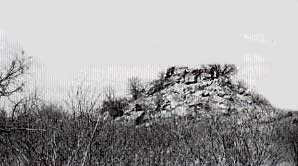
Photo from the book, Savage Frontier, by Stephen L. Moore
Thanks to the invaluable history written by Mr. Webb called The
Texas Rangers, we have Lieutenant Van Benthusen first-hand account
of the fight.
“I stood at the top of this mound until I saw about one hundred
and fifty mount their horses and come towards us. I then ran down
and stationed my men in a point of timber; the Indians immediately
charged upon us, uttering the most savage yells. They soon surrounded
our little party of eighteen men, and for about two hours a severe
fire was kept up on both sides without ceasing, most of the time they
were not farther than fifteen or twenty steps; they were led on by
a chief who was most splendidly mounted; our men shot this forward
chief down, when the savages ceased firing and fell back for some
distance; I thought the battle was over; but I was mistaken, for in
about fifteen minutes the Indians again advanced upon us, led by another
chief. At this time I had lost but four men and six horses.
Presently we discovered a smoke rising around us, the Indians had
made a ring of fire completely around our position, the fire was advancing
rapidly, our only alternative was to leave our remaining horses and
charge the savages on foot. The charge lasted about ten minutes; six
more brave men fell in routing the Indians… We then commenced
our retreat on foot.” The retreat with the wounded men required
seventeen days, ending at the Sabine on November 27, after an absence
of fifty-eight days.
This story is also referred to as the Battle of the Knobs. Get the historical marker information by clicking here.
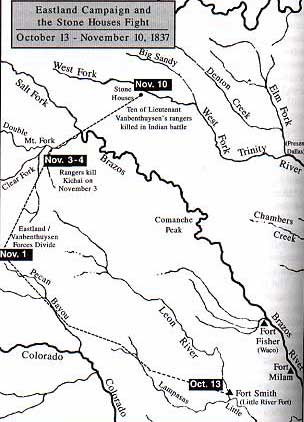
Map from the book, Savage Frontier, by Stephen L. Moore
The following narrative, related by one of the few survivors of the
engagement known as the Stone House fight, furnishes a striking example
of the trouble that may result from the reckless deed of one unscrupulous
individual.
It was, I think, late in the summer of 1837, during the temporary
truce growing out of my missionary labors, that Captain Eastland,
then in command at Coleman's fort, led an expedition up the Colorado
river to the mouth of Pecan bayou and out on the latter stream to
its source.
The precise object of the expedition, if there was any, I know not,
but my impression is, that during the temporary lull in the Indian
wars, the rangers at the fort became restless; and, partly to give
them exercise and employment, and partly to take advantage of the
cessation of hostilities to explore the unknown territory with perhaps
a view to future operations against its wild inhabitants, Captain
Eastland planned the jaunt. Be that as it may, he evidently had no
intention of making hostile demonstrations against the Indians, and,
having reached the head of the bayou, gave the order to return. A
part of the company, some eighteen or twenty men, refused to obey
the order, and, bent on further adventures, set out in a northerly
direction, going on till they reached the rock mounds known as the
stone houses, in the vicinity of which there was quite a large Indian
encampment, composed of several small tribes, who for safety had formed
an alliance against the more powerful tribes. Among the Indians were
some Delawares, who went out to the white men's camp, and while there
a lone warrior was seen approaching from the direction of the encampment.
Felix McClusky, the wild Irishman before mentioned, at once gave
chase to the lone Indian. The Delawares tried to stop him, and, when
he came within hailing distance, his victim made signs that he was
a friendly Indian; but McClusky, heedless of signs or consequences,
ran onto the savage and killed him, taking his scalp and rifling his
pockets. The Delawares, thereupon, warned the men that the murdered
Indian was of a friendly tribe, and his comrades would certainly avenge
his death. Some of the men began to upbraid McClusky for his ruthless
deed. Exhibiting a chunk of tobacco extracted from his victim's pocket,
he recklessly swore that he "would kill any Injun for that much
tobacco."
The Delawares made haste to withdraw themselves from the men's camp,
and, true to their prediction, the little party was soon confronted
by a hundred warriors clamoring for the man who had killed their comrade.
McClusky wasn't hero enough to give himself up to save the lives he
had imperiled, and, of course, his companions would not give him over
to the hands of the fiends, who would have tortured him to death by
slow degrees, so there was nothing for it but to make the best defense
possible.
Entrenching themselves in a ravine, they held their assailants at
bay till the Indians at length set the grass on fire and, sending
some of their party around to cut off retreat, awaited the result.
The only hope of escape then lay in cutting their way through the
enemy's lines. This they attempted to do, only five succeeding, two
of them being wounded. But for the reckless bravado of the Irishman
they might have hunted and explored the country unmolested. As is
usually the case, the innocent had to suffer, McClusky being one of
those two who escaped.
He was afterward killed in a drunken brawl.
The following account of the Stone Houses Fight is from the book, Indian Depredations in Texas, by J.W. Wilbarger:
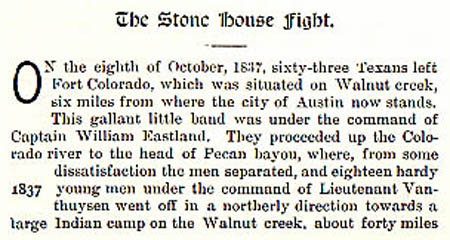

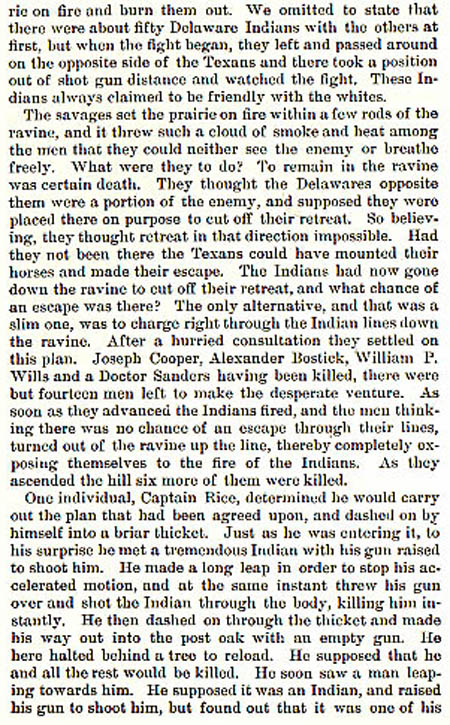
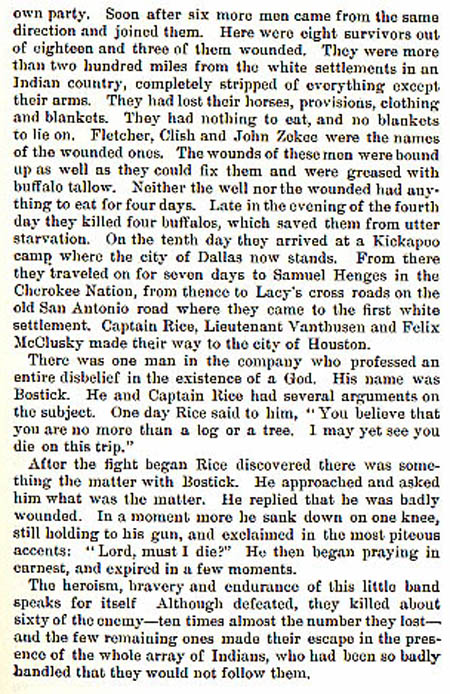
|






